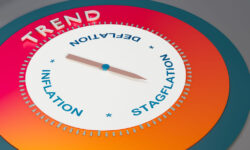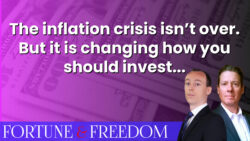They say that admitting you have a problem is the first step to recovery. But they don’t tell you how many more steps are left… It seems to me that the consequences of inflation and recession at the same time are dawning on investors. But figuring out what to do about it is proving a lot more difficult. Which investments are stagflation proof? We don’t have much historical evidence. Just the 1970s, really. What should one do if that era was unique? If stagflation is inflation and recession, then figuring out which assets do well in those environments is a good start.
Investing for inflation is tough. Commodities, property, companies that produce consumer staples, and companies with a lot of pricing power are top of the list of inflation-proof investments.
It’s best to avoid bonds during inflation because the value of money is falling. The only thing worse than cash during inflation is a promise to pay cash in the future (the definition of a bond).
You can change your consumer habits too, of course. It’s best to buy things as soon as possible, before prices go up or shrinkflation reduces how much is in the box. Of course, this buying spurt helps cause inflation…
During a recession, bonds are a good bet because they are unlikely to fall in value. In the worst case, you just wait for the repayment of the bond. This certainty bids up the price of bonds, often delivering capital gains during recessions.
It’s best to avoid discretionary spending-based companies because spending gets shifted to the necessities of life rather than luxuries. But even consumer staples can see spending fall in a recession.
All that’s nice and simple. Intuitive, even.
But what do you do when you get both a recession and inflation at the same time? Stagflation makes a real mess of things. Especially in theory.
You have to discard many of the investments you’d have considered under the individual scenarios of inflation and recession. And some which you discarded are back on the menu.
For example, corporate bonds begin to look risky under stagflation because companies can go bust in a recession. Combine this with the inflation threat and it’s return-free risk.
Industrial commodity prices can fall as the economy slows, despite inflation raising consumer prices. This makes some commodities a trap because inflation should preserve their value, but it’s still a supply and demand game in the end.
And government bond prices can rally as there’s a flight to safety. Losing 10% on such bonds to inflation becomes preferable to losing 30% to stocks as a result of a recession that crushes corporate profits, for example.
All that’s the theory. But historical analysis has a very hard time backing up the usual claims we hear about these things.
There’s a big difference between trying to get ahead and trying to preserve your wealth during stagflation. The fact that many investors focus on capital preservation is a give-away of just how hard it is to succeed.
Returns can also depend on the rate of inflation and the severity of the recession, for example. If we get a financial crisis, rather than just a recession, everything gets routed.
I recall a detailed analysis which concluded that inflation up to 4%, which we used to consider high, is good for stocks. Beyond that, they get into trouble.
As for bonds, you can consider foreign bonds to add exchange rate risk. Why add risk? Well, because risk and return are linked. Every investment has risk. And more risk offers more return.
In a financial crisis, the US dollar tends to rally. It has over the past six months, so UK investors buying US dollar bonds did OK, despite those bonds falling in price and paying less than inflation.
But the answer to all of this may be surprisingly simple. Investing is about starting points, not just trends.
Even the best investment strategy and the most powerful trend is going to be a dud if you buy at the wrong time.
The internet, for example, has delivered spectacular economic and financial gains for billions of people. And yet, if you bought at the peak of the dot-com mania… well, you probably would’ve given up on it at some point.
House prices are supposed to be a great way to protect your wealth from inflation. But if you buy into a housing market that is already at extreme valuations, it just isn’t going to work out well. Perhaps that’s why UK house prices are falling as stagflation takes hold.
This is why historical analysis of what investments worked in what environments in the past is only a start of the process. You also have to do the maths to figure out whether your chosen investments are looking like a reasonable bet. (Or you can ask someone else to do the maths for you.)
Gold performed outrageously well as an investment in the 1970s. But it had been illegal to buy it before then, which suppressed the price. That made the 1970s a fantastic starting point for gold investors.
Another question is which force wins in the end – inflation or recession?
Our present bout of stagflation begins at a time of extreme government debt, which means we may not be able to take the tough medicine that got inflation under control in the 1970s, at the expense of the economy.
If the end outcome is inflation instead of recession, that rewrites the history books for which investments work best.
It seems to me that, although inflation and recession are familiar beasts, and some of us can even remember stagflation, we are in uncharted waters, with only past wrecks to guide us.

Nick Hubble
Editor, Fortune & Freedom




